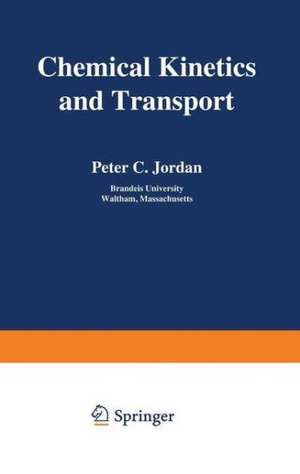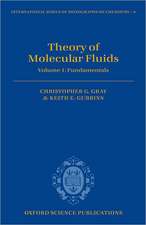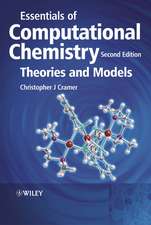Chemical Kinetics and Transport
Autor Peter Jordanen Limba Engleză Paperback – 4 aug 2012
Preț: 393.35 lei
Nou
Puncte Express: 590
Preț estimativ în valută:
75.28€ • 78.49$ • 62.56£
75.28€ • 78.49$ • 62.56£
Carte tipărită la comandă
Livrare economică 21 martie-04 aprilie
Preluare comenzi: 021 569.72.76
Specificații
ISBN-13: 9781461591009
ISBN-10: 1461591007
Pagini: 388
Ilustrații: XVI, 368 p.
Dimensiuni: 155 x 235 x 20 mm
Greutate: 0.54 kg
Ediția:Softcover reprint of the original 1st ed. 1979
Editura: Springer Us
Colecția Springer
Locul publicării:New York, NY, United States
ISBN-10: 1461591007
Pagini: 388
Ilustrații: XVI, 368 p.
Dimensiuni: 155 x 235 x 20 mm
Greutate: 0.54 kg
Ediția:Softcover reprint of the original 1st ed. 1979
Editura: Springer Us
Colecția Springer
Locul publicării:New York, NY, United States
Public țintă
ResearchCuprins
1. Kinetic Theory of Gases—Equilibrium.- 1.1. Introduction.- 1.2. The Maxwell-Boltzmann Distribution of Velocities.- 1.3. Determination of Pressure.- 1.4. Properties of the Maxwell Distribution.- 1.5. The Molecular Flux and Effusion of Gases.- Problems.- General References.- 2. Kinetic Theory of Gases—Transport.- 2.1. Introduction.- 2.2. Mean Free Path.- 2.3. Collision Frequency.- 2.4. Macroscopic Equations of Transport.- 2.5. Solution of the Transport Equations.- 2.6. Kinetic Theory of Transport and Postulate of Local Equilibrium.- 2.7. Simplified Transport Theory: Dilute Hard-Sphere Gas.- 2.8. Comparison with Experiment.- Appendix. Coordinate Transformation by Jacobian Method.- Problems.- General References.- 3. Electrolytic Conduction and Diffusion.- 3.1. Introduction.- 3.2. Ionic Conduction in Solution—a Review.- 3.3. Nernst-Einstein Relation.- 3.4. Electrolyte Diffusion.- 3.5. Stokes’ Law and the Microscopic Interpretation of ?0.- 3.6. The Mobility of H+ and OH- in Water.- 3.7. The Concentration Dependence of ?.- 3.8. The Wien Effects.- Problems.- General References.- 4. Determination of Rate Laws.- 4.1. Introduction.- 4.2. Stoichiometry, Rate Law, and Mechanism.- 4.3. Elementary Rate Laws and the Principle of Mass Action.- 4.4. Reaction Order and Molecularity.- 4.5. The Principle of Detailed Balance.- 4.6. Experimental Methods for Determining Rate Laws.- 4.7. Integrated Rate Laws—First Order.- 4.8. Isolation Methods.- 4.9. Relaxation Methods.- 4.10. Determination of Rate Law from Data—Two Examples.- 4.11. Temperature Dependence of Rate Constants.- Appendix. Linear Least-Squares Analysis.- Problems.- General References.- 5. Stationary State Mechanisms.- 5.1. Introduction.- 5.2. Consecutive Reactions—First Order.- 5.3. ConsecutiveReactions—Arbitrary Order.- 5.4. Unimolecular Decomposition—Gases.- 5.5. Radical Recombination—Gases.- 5.6. Complex Mechanisms—Gaseous Chain Reactions.- 5.7. Simple Mechanisms—Solution.- 5.8. Complex Mechanisms—Solution.- 5.9. Homogeneous Catalysis.- 5.10. Enzyme Catalysis.- 5.11. Heterogeneous Catalysis.- Appendix A. Matrix Solution to the Coupled Rate Equation (5.2).- Appendix B. Approximations to ?+ and ?-.- Problems.- General References.- 6. Photochemistry.- 6.1. Introduction.- 6.2. Measurement of Intensity.- 6.3. Spectroscopic Review.- 6.4. Primary Processes.- 6.5. Secondary Processes.- 6.6. Chemiluminescence.- 6.7. Orbital Symmetry Correlations: Woodward-Hoffman Rules.- 6.8. Laser Activation.- 6.9. Laser-Controlled Isotope Separation.- Problems.- General References.- 7. Nonstationary State Mechanisms.- 7.1. Introduction.- 7.2. Thermal Explosion.- 7.3. Population Explosion—Autocatalysis.- 7.4. The Lotka Problem: Chemical Oscillations.- 7.5. The Belousov-Zhabotinskii Reaction.- 7.6. Other Oscillating Systems.- 7.7. Multiple Stationary States: The NO2-N2O4 Reaction.- Problems.- General References.- 8. Single-Collision Chemistry.- 8.1. Introduction.- 8.2. Reaction Cross Section: Relation to the Rate Constant.- 8.3. Scattering Measurements—Molecular Beams.- 8.4. Reaction Cross Section: Hard-Sphere Model.- 8.5. Reaction Cross Section : Ion-Molecule Systems.- 8.6. Reaction Cross Section : Atom-Molecule Systems.- 8.7. Product Distribution Analysis.- 8.8. Direct, Forward-Peaked—The Ar+ + D2 System.- 8.9. Recoil—The D + Cl2 System.- 8.10. Collision Complexes—The O + Br2 System.- 8.11. State Selection Experiments.- Problems.- General References.- 9. Theories of Reaction Rates.- 9.1. Introduction.- 9.2. Potential-Energy Surfaces.- 9.3. ActivatedComplex Theory.- 9.4. Model Calculations of k2(T).- 9.5. The Kinetic Isotope Effect.- 9.6. Unimolecular Reaction—General Features.- 9.7. Unimolecular Reaction—RRKM Theory.- 9.8. Critique of RRKM Theory—Isomerization of Methyl Isocyanide.- 9.9. Thermodynamic Analogy.- 9.10. Gas-Phase Reactions.- 9.11. Solution Reactions.- 9.12. Primary Salt Effect.- 9.13. Diffusion-Limited Kinetics—Debye Theory.- Appendix A. Statistical Thermodynamics.- Appendix B. Evaluation of k? in RRKM Theory.- Problems.- General References.- 10. A Dynamical Model for Chemical Reaction.- 10.1. Introduction.- 10.2. Kinetic Energy of a Triatomic System.- 10.3. Model for Inelastic Collision.- 10.4. Effects Due to More Complex Potential-Energy Surfaces.- 10.5. Model for Thermoneutral Chemical Reaction.- 10.6. Exoergic Reactions.- 10.7. Endoergic Reactions.- 10.8. Noncollinear Geometries.- 10.9. Realistic Scattering Calculations.- Problems.- General References.- Physical Constants.










